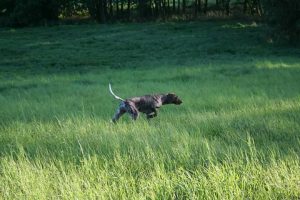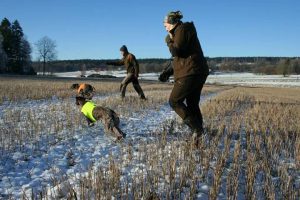Too much of a gundog – by Tok Mostert
As I walked through the door of the large gunshop, the familiar aroma of gun oil mixed with freshly ground coffee filled my sense of smell. The well stocked bookshelves drew my attention and I headed to the dog training section, maybe hoping to find a quick fix to training a better gundog. With a pile of books under my arms, I settled in the plush leather couch to learn a thing or two, I did learnt something, but not what I wanted.
The generic layout is one thing, but every chapter in every book that covers selecting a puppy may as well have been plagiarism, it is way too one dimensional and generic. Pages and pages of breeders and breeds, what dog does what and how to select your puppy. You can speak to several top trainers and breeders and you will get a diverse opinion on how to select a pup, almost everyone has their own way of picking a dog from a litter. The basics is and always will be, reputable breeder and pure bloodlines. That is a good baseline start, but I have seen untypical dogs that do not adhere to the breed standard hunt circles around the show pony dogs, the same for breed royalty.

There is no guarantee that even with the best breeder and the best litter, you will get what you want in a dog, besides the dogs personality there is one essential thing that is going to determine whether the dog turns out to be what you expected, YOU!
As a ex Professional Hunter I’ll tell you we used the term over gunned when a client arrived with a large caliber rifle that he could not shoot well, it happens more often than I like, but too much gun is a bad thing, just like too much dog is. The very first consideration anyone should have when selecting a breed or puppy should be their ability or level of experience with training a dog. Hard dogs will find every single weakness you have and exploit it to the fullest! Many, many handlers eventually turn to the e-collar for help out of despair, they should have made it easy on themselves and picked a dog that could suit their ability. I fully understand the wish, need or desire to have a huge, hard working and strong male dog, but can you handle his stubborn manner and contain and channel his exuberance? Anyone that has ever trained two dogs from the same litter, knows that the two individuals need individual training methods and adjustments.
Take a long hard look at yourself and acknowledge your ability and skills, then select a puppy to suite your ability. A first time owner that knows nothing about training dogs is far better off with a mild mannered dog than a wild spirited dog. Nothing wrong with either, as long as they match your ability.
Too much dog for your ability will simply frustrate and infuriate you, along with making you negative. It is also the reason why some handlers only train what the dog is good at, a sure way of wasting the dogs potential and true ability. Running too much dog that does not listen or obey you, is far worse than running a mild dog that follows your commands and responds to your instructions. You are also more likely to succeed on field and retrieving with the mild dog, blood tracking being the exception were the hard dog may be better.
Personally I believe even a average breeder can deliver a top dog, it all depends on the handler and trainer. My method may not be conventional or rational, but it works for me. Choose wisely, train smartly and hunt well!
Tok Mostert, a Professional Hunter from South Africa, now living in Sweden, is sharing his writings on dog training with us. You can start reading them from Part 1 here.


